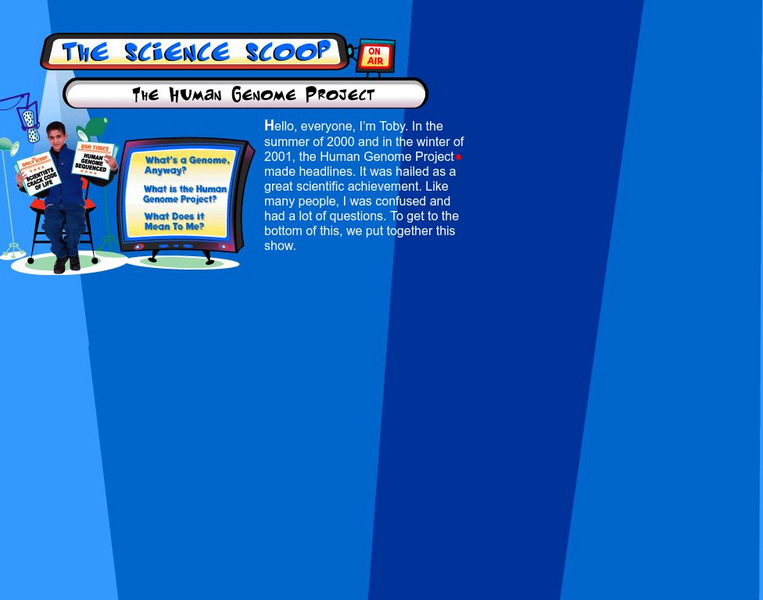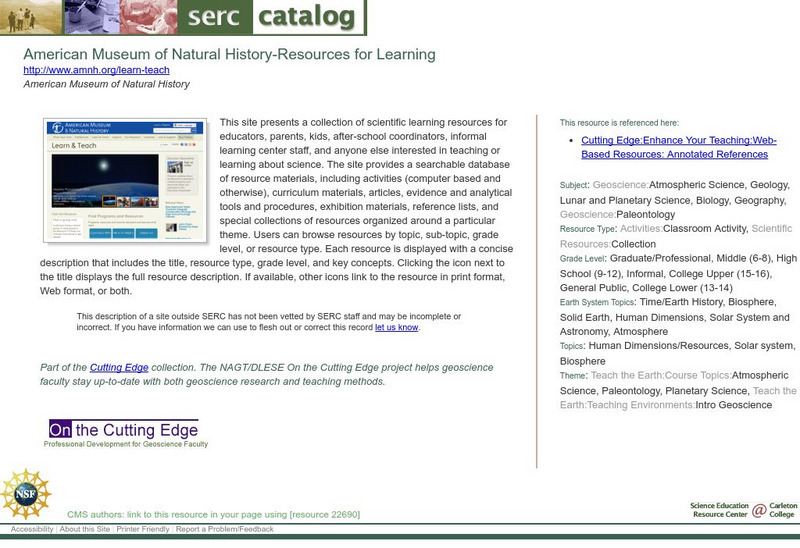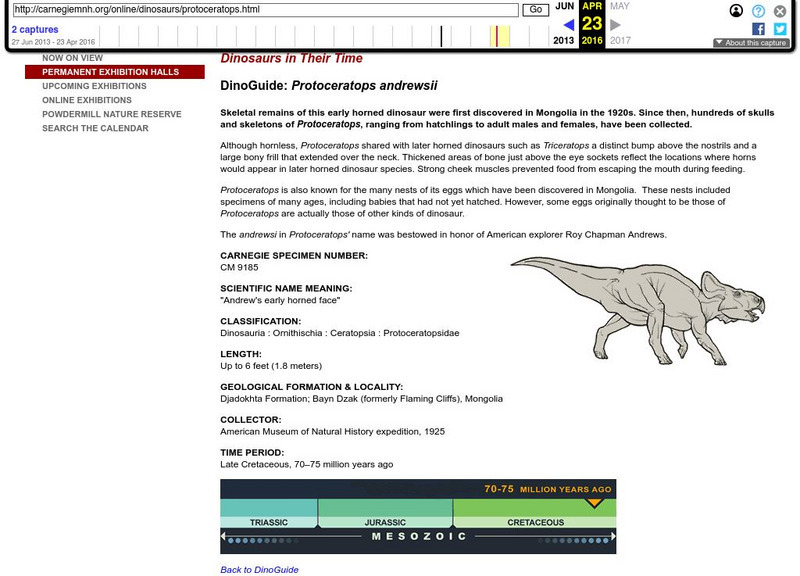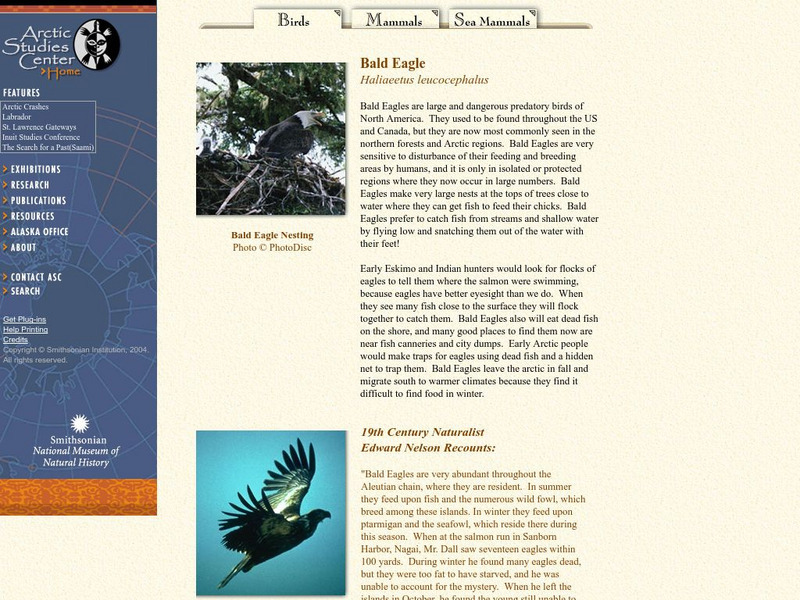American Museum of Natural History
American Museum of Natural History: Ology: Cosmic Cookies
Roll your mouse over the planets in our solar system to read a vignette about each. Then, link to the recipe for directions to create miniature planet cookies that look like the real thing.
American Museum of Natural History
American Museum of Natural History: Ology: Milky Way Galaxy
How big is a billion? Find out some interesting facts about our galaxy, the Milky Way, and its billion stars.
American Museum of Natural History
American Museum of Natural History: O Logy: Stuff to Do: Start a Rock Collection
Step-by-step details for building a rock collection, beginning with collecting specimens, moving on to observing and sorting rocks, and finishing with displaying the collection. Includes a data table for keeping track of all your...
American Museum of Natural History
American Museum of Natural History: O Logy: How Did the Universe Begin?
Bite-size introduction to two scientists-Hubble and Lemaitre-who played key roles in formulating the theory of the origin of the universe known as the big bang. Includes an interactive timeline on which you can plot out the approximate...
American Museum of Natural History
American Museum of Natural History: O Logy: Stuff to Do: Moon Watch Flip Book
Hands-on activity shows you how to make a flip book of the moon using close observation skills and simple materials. Includes animation that lets you view the moon in action through its different phases, worksheets, and illustrated...
American Museum of Natural History
American Museum of Natural History: O Logy: Light, Matter, Energy
Learn how Einstein revolutionized how we think about light, matter, and energy by asking challenging questions and questioning old ideas.
American Museum of Natural History
American Museum of Natural History: O Logy: Stuff to Do: Light Quest
Light Quest activity, for two to four players, designed to explain how atoms create light and where photons come from.
American Museum of Natural History
American Museum of Natural History: O Logy: Human Genome Project
Get the science scoop on the Human Genome Project by considering the answers to these three questions: What is a genome? What is the Human Genome Project? What does it mean to me?
American Museum of Natural History
American Museum of Natural History: O Logy: Stuff to Do: Dna in a Blender
Follow these illustrated instructions to conduct a simple experiment in separating DNA from an onion!
American Museum of Natural History
American Museum of Natural History: Ology: Astronomy: In Pictures: Beyond Planet Earth
What would it be like to travel across the solar system and explore space? Take a look at some of the places that humans might go to someday, and the questions that scientists are asking.
American Museum of Natural History
American Museum of Natural History: Ology: Brain: Boost Your Brain Power!
Test how good and how quick your visual memory is in these games of recall.
American Museum of Natural History
American Museum of Natural History: Ology: Life in the City
Explore a city park to learn what tiny species live there.
American Museum of Natural History
American Museum of Natural History: Resources: Time Dilation Equation
Using an example of light bouncing back and forth between two mirrors in a rocket, time dilation is explained in this resource. Step-by-step calculations using Einstein's time dilation equation are shown.
University of Florida
Florida Museum of Natural History: About the Florida Bay
Explore the habitats found where the Everglades run into the sea. A wonderful resource for learning about a unique part of the world.
Science Education Resource Center at Carleton College
Serc: American Museum of Natural History Resources for Learning
This site presents a collection of scientific learning resources for educators, parents, kids, after-school coordinators, informal learning center staff, and anyone else interested in teaching or learning about science. The site provides...
American Museum of Natural History
American Museum of Natural History: O Logy: Stuff to Do: Stargazing
Get started on the road to becoming an expert stargazer by following these recommendations for identifying stars, planets, and constellations. Includes an example of a journal that can be used as a record of your investigations.
American Museum of Natural History
American Museum of Natural History: O Logy: Stuff to Do: Make a Weather Station
Make a wind vane, rain gauge, and barometer and learn how to measure wind direction, rainfall, and air pressure.
American Museum of Natural History
American Museum of Natural History: O Logy: Stuff to Do: Atomic Mobile
Illustrated instructions for how to make a model of an atom (an atom mobile).
University of Florida
Florida Museum of Natural History: Body Features and Measurements of a Bony Fish
Contains labeled diagrams showing bony fish external anatomy.
Carnegie Museum of Natural History
Carnegie Museum of Natural History: Carnegie's Dinosaurs: Dino Guide: Protocerato
This resource presents a brief overview of the Protoceratops.
Smithsonian Institution
National Museum of Natural History: Repatriation
"Repatriation", returning to one's origin, is a program running through the Smithsonian examining Native American artifacts.
Smithsonian Institution
National Museum of Natural History: Laysan Albatross
This Smithsonian website has a brief, but thorough, article on the Laysan Albatross that also includes a picture.
Smithsonian Institution
National Museum of Natural History: Hall of Mammals: Giant Anteater
Brief illustrated overview of the giant anteater and an accompanying video demonstrate how this "food specialist lives up to his name".
Smithsonian Institution
National Museum of Natural History: Bald Eagle
This Smithsonian website has a brief but thorough article on the Bald Eagles. Content also includes pictures and an extensive quote from naturalist Edward Nelson as he discusses the role of eagles in Eskimo myth.



















